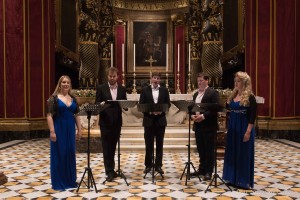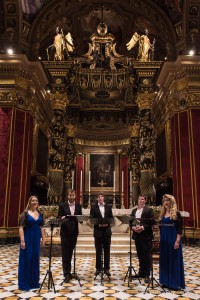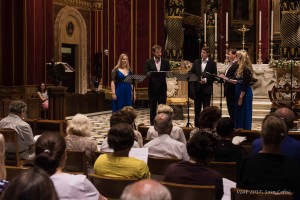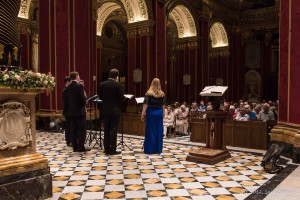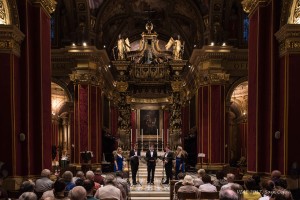Top London vocal ensemble Eo Nomine in two wonderful concerts
Eo Nomine, a group of 5 extremely accomplished singers, gave two wonderful concerts for this year’s VIAF. The two concerts were incorporated in the Baroque/antique music week that has become a staple within the wider framework of VIAF.
As the leader of the ensemble, Angus MacPhee, explained, the first concert was largely concentrated on late Renaissance music. Angus gave a most interesting exposition, following the stylistic features prevalent in the motets of Byrd, Tallis, White, and others, and how these then led to the more florid figurations one finds in Baroque writing. The first concert was performed on Tuesday 20 June and it took place in St George’s Basilica, itself a wonderful example of Baroque architectural and artistic glory.
Motets featured Dunstable’s Ascendit Deus, which was hauntingly rendered by three soloists as a processional from the back of the church. As could be discerned in this piece, Dunstable’s influence on European music was heard in his flowing, gently asymmetrical rhythms and, above all, in his harmonies. He represents a culmination of the English tradition of full, sonorous harmonies based on the third and sixth that persisted through the fourteenth century alongside the starker, more dissonant style of continental music.
Four motets by William Byrd, Gaudeamus Omnes, Timete Dominum, Iustorum Animae, and Beati mundo corde were performed, all of them beautiful motets typical of this great English composer. In the first one, the listener was plunged from grief to ecstatic, energetic joy. An introit for the Feast of All Saints, the first of a sequence of four motets all composed for the feast day, this short work was rhythmically complex to a degree almost unknown in Byrd’s music, its intricacy barely contained within the quick minim pulse that underpinned its restless forward motion and darting syncopations. The composer took the opening exhortation “Gaudeamus omnes” (“let us rejoice”) to heart, and every bar danced with celebration. A short three-voice verse section (“Exultate iusti”) pulled things back to some semblance of solemnity, but it could be sustained for long before the thick polyphony of the “Gloria” section brings us to a thrilling close. Timete Dominum is a more austere work, while Iustorum Animae is striking not on account of any overt drama or epic scale but rather on account of its perfect structural and motivic balance; certainly the gradual and very subtle transitions between homophony and polyphony betrayed the hand of both a skilled and a very experienced composer. The opening passage is set without real counterpoint or imitation of any kind. As Byrd, and Eo Nomine, warmed to the quiet passion of the text (with its reflective ponderance on death) some highly original echo-effects and imitation began to unfold, and the composer’s lifelong love of chromatic cross-relations became apparent. The texture here was crystal clear, with the voices maintaining their individuality yet networking beautifully as an ensemble. A little later on, a flowing passage in four-voice sequential stretto imitation showed, by contrast, how very restrained and subtle the rest of the work is. Harmonically, Byrd’s design came across as strikingly ‘modern’, making almost exclusive use of fifth-relations and allowing the bass voice to achieve an independence that would have been impossible in his earlier music.
Beati mundo corde, the Communion hymn, is a setting of some words from the Beatitudes. Byrd starts with just three voices for the first phrase, before moving to four voices and then five in a completely satisfying setting of a text which must have spoken clearly to the Catholic community. This is a five-part Latin motet, another example of Byrd as master musical architect. The rather lengthy text comprised three verses from the Sermon on the Mount, and Byrd set them for three, four and five voices in progressively longer sections. Byrd is sometimes most at home in highly sectionalized forms, and this work moved through its divisions with an elegance of writing typical of Byrd. He even indulged in a little madrigalism: over the words “Blessed are they who are persecuted for righteousness’ sake”, he throws up false relations and dissonances reflecting (obliquely) the plight of the Catholic Church in Elizabethan times. This work is the last in Byrd’s All Saints cycle. Its stylish and effective writing made a most fitting end to a highly structured and effective group of works sung by Eo Nomine.
Robert White’s Christe Qui es et Lux Dies followed the established pattern of alternating plainchant verses with polyphonic ones that incorporate the chant, in this instance in the tenor part. Its text, an evening prayer for peaceful rest, was full of imagery of light and darkness.
One of the giants of Renaissance music in England, Thomas Tallis was an English composer who occupies a primary place in anthologies of English choral music, and is considered one of England’s greatest composers. He is honoured for his original voice in English musicianship. O Salutaris Hostia‘s melody was vaguely reminiscent of the hymn’s opening chant melody. Tallis even repeats the same imitative gesture a second time, with a balanced cadence establishing the home key. He completed the textual thought by means of a second imitative motive, once again streaming down from on high; this time the imitation transpired thrice, with a climactic leap to the highest note in the soprano voice. The second half of the text, which bemoaned the oppression of foes that surround humankind, Tallis set to a denser musical texture, using more notes and more complicated imitative patterns and avoiding home-key cadences. Yet hope, returned in the fourth line of text, and the composer devoted nearly half of the motet’s length to this line, underscoring the assistance that will come from the Saving Victim. Twice the ensemble returned to its original order of entry, singing an upward-leaping motive of supplication, followed by many extended reiterations of the word “help.”
A second Tallis motet was If Ye Love Me. This was the classic example of the ‘new’ English anthems: mainly homophonic, but with brief moments of imitation. Like many early Anglican anthems, it is cast in ABB form, the second section repeated twice.
Throughout, Eo Nomine sang with consummate poise and grace, each voice blending seamlessly with the other. Clarity of lines, articulation of text, and wonderful phrasing were the hallmarks of this performance.
The second Eo Nomine concert took place two days later, on Thursday 22 June at the Aula Mgr G. Farrugia, where the beautiful Baroque organ of the Basilica lives. For this concert, which consisted entirely of Baroque pieces, Eo Nomine was joined by accomplished organist Joe Waggott. Entitled ‘In Guilty Night’, the programme consisted of works by Purcell, Blow, Gibbons, Locke, and others. Starting with Purcell’s Let Mine Eyes Run Down With Tears, the audience could discern the completely different style that the ensemble adopted for these works. From the classicism of Renaissance proportion and poise, Eo Nomine betrayed a more exuberant and rich texture to complement the nature of the works chosen for performance. The first Purcell work showed the composer deploying his forces and his structuring of the anthem as masterful. The anthem is for five parts accompanied only by basso continuo and his rich harmonies and original melodic language could be found throughout the piece. In the first section Purcell engaged heavily in word-painting, from the opening downwards flowing melisma which represented tears, to the sense of desolation in the word ‘broken’, the false relation at ‘great breach’ and the sudden downwards plunge at ‘very grievous blow’.
At ‘If I go forth into the field’ there was a recitative-like section for the tenor and bass followed by the five voices uniting for ‘Hast thou utterly rejected Judah? Hath thy soul loathed Sion?’ Purcell made his five voices pass the short phrases in the next line between them in a manner which was both mournful and almost angry making them unite when they came to ‘and there is no healing for us?’ He ended with the tension and grief laden ‘We looked for peace, and there is no good’. The ensemble ‘We acknowledge, O Lord’ provided a respite from the stress and desolation of the text but this proved to be temporary as we moved into the third and final part of the anthem. This was marked by the voices pleading and begging The Lord to ‘remember’ followed by the cry of desperation of ‘Oh do not disgrace the throne of thy glory’. There then followed the tenor singing ‘Are there any among the vanities of the gentiles’ which was followed by ‘Art thou not he?’ and the resigned final chorus of ‘Therefore will we wait upon thee, O Lord’, which brought this starkly moving masterpiece to an end. Through this rather lengthy piece, Eo Nomine had the occasion to display the beautiful voices of each of the singers making up the ensemble. From the resonant bass to the mellow tones of the tenor, moving on to the sensual alto and crystal clear sopranos, this was a most impressive rendering of a very difficult piece.
The same could be said of the other Purcell works performed, namely, Remember not Lord our Offences. The anthem’s atmosphere was highly charged from the very first word which Purcell’s set as a block chord and then reiterated as the phrase moves towards ‘our offences’. He then repeated the first phrase of the text in the relative major. Purcell made his first use of counterpoint in the anthem at ‘nor th’ offences of our forefathers’, and spurred up the tension at ‘neither take thou vengeance of our sins’, by always countering it in at least one voice with the rising phrase ‘but spare us, good Lord’. As the anthem progressed, the calls for God to show mercy to ‘spare us’ become ever more strident and the sense of urgency was increased by Purcell’s use of chromaticism and discord. The anthem’s climax came with a desperate plea ‘Spare us, good Lord’ . The fifth line ‘Spare thy people, whom thou has redeem’d’ introduced a calmer and more supplicatory mood with more relaxed harmonies being heard at ‘redeem’d’ and a beautifully fluid melodic line at ‘for ever’. Purcell ended the anthem as he began it with a prayer for salvation. The full emotional gamut was explored by Eo Nomine, making of this piece a highly-charged experience.
The third Purcell work performed during this concert was the famous In Guilty Night. The anonymous text of this song tells the story of Saul immediately before the Battle of Gilboa. Saul fears he will be defeated, and he has a witch call up the spirit of Samuel to tell him his fate. Purcell wrote for this text a complete dramatic scena in an operatic style. Although only nine minutes long, a complete dramatic moment is depicted in an Italian arioso style filled with power and mystery.
The words that open the scena are “In Guilty Night”, and the opening mood is dark and foreboding. The three voices, Soprano, Tenor, and Bass, enter one by one quietly in chromatic harmonies that climb up from the netherworld. Over the words “in false disguise” are suspensions and dissonances as more and more tension is created. The main part of the opening is the setting for the words “Forsaken Saul”. Saul has been forsaken by God and is, consequently, damned. On just those two words, Purcell created three sections of impressive imitative material descriptive of Saul’s complete forsakenness. They are set to a falling motive in imitative and chromatic harmonies that sighed downwards and then climbs up to a climax. On the final setting of the words, the soprano began fortissimo, very high, alone crying dramatically “Forsaken Saul!”, then started the downward climb to the end of the section. All the voices joined in imitatively as the theme winds its way to its close.
The central part of the piece unfolded as the dramatic dialogue, first between Saul and the witch, and then after Samuel was raised, among all three characters. Saul is a tenor, and sounded heroic in the role. Samuel is a bass, and with the heavier tessitura Angus MacPhee’s voice became loaded with a more ominous and noble feeling. There was a great amount of word painting and expressive treatment of the text, to get out of the text all of the emotions therein. The music was made up of Italian recitative and arioso style writing. The lines are long, flexible, and eloquent.
Other works performed were Orlando Gibbons’ This is the Record of John, a work that is often cited as the quintessential example of its genre, the verse anthem. Anglican church music in the Tudor period included choral settings of the English service and two types of piece called ‘anthem.’ They were distinguished by scoring and disposition of voices. The full anthem, a choral setting of mainly Biblical or liturgical texts, roughly took the place of the Latin motet. More complex settings (verse anthems) of some texts appeared, in the hands of Gibbons as well as William Byrd, Richard Farrant, William Mundy, and Thomas Morley. These pieces juxtapose full choral passages and sections with solo voices and instrumental accompaniment.
In the case of This Is the Record of John, the full, five-voiced choir alternated with passages for a single countertenor voice; either an organ or an instrumental consort of five viols accompanies the soloist. For the evening’s performance, the organ was used. In a subtle way, the verse anthem genre, with its intrinsic dialogue between a solo voice and a larger group, was the perfect vehicle for this text. The verse anthem of the time implied no specific formal structure; Gibbons chose a simple threefold alternation between solo and choir, with the choir in each case echoing the final phrases of the soloist’s text. The melodic writing for the solo voice was quasi-declamatory, supple, and fluid. The accompaniment often included cadential flourishes and brief imitative motives (some also imitate the voice). The choral writing remained reasonably direct, although it, too, contained textural alternations between chordal homophony and imitation. The third solo passage presented some almost madrigalian effects: when John quotes Isaiah and calls himself the “Voice of him that crieth in the wilderness,” Gibbons’ harmonies suddenly shifted to a remote minor; the text, however, continued with the command to “make straight the way of the Lord,” and the harmony instantly returned to the tonic.
Other works by Boyce, Locke, and Blow continued to showcase the consummate vocal and musical mastery of Eo Nomine. It is no wonder that this group enjoys such critical acclaim wherever they perform!




